�
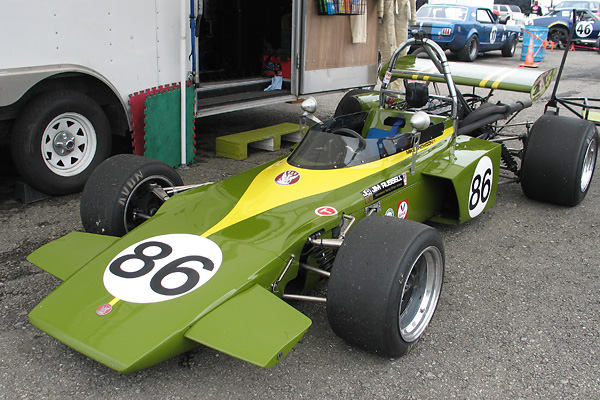
�
Michael Snowdon's G.R.D. 272 Formula Two Racecar, Number 86
� � Owner: Michael Snowdon� City: Ile Cadieux, Quebec
� Model: 1972 G.R.D. 272
� Engine: Ford BDE 1.8L DOHC 16-valve I4
� Restored by: Peter Denty Racing�
�
A Phoenix Born from Lotus Ashes
��
In 1971, Lotus ceased production of race cars for outside customers to focus �
resources on their road car division: Lotus Cars Limited. The Lotus flag �
would still be carried in Formula One by Team Lotus, but the team operated �
independently and the cars it used weren't offered for public sale. Team Lotus �
had already won the Formula One championships for 1970, and they would continue �
to win the championships for 1971 and 1972. They continued designing Formula One �
cars for many more seasons. However, some very talented race car designers and �
builders lost their jobs with the closure of the race car division: �
Lotus Components Limited. �
�
Mike Warner, who had long been the chief executive of Lotus Components, looked �
for a way to resume operations. Partnering with a local engineering company �
called Griston, he recruited designer Dave Baldwin, and lead technicians Derek �
Wild and Gordon Huckle to form Group Racing Developments. (Baldwin had designed�
the successful Lotus 59, 59A, and 69 tubular spaceframe cars. He's also credited�
with completing the design of the Lotus 73 which was a monocoque chassis �
Formula 3 car.) Warner also recruited Swiss race car designer Jo Marquart who �
had worked at Lotus through the sixties before brief stints at McLaren and Huron. �
�
�
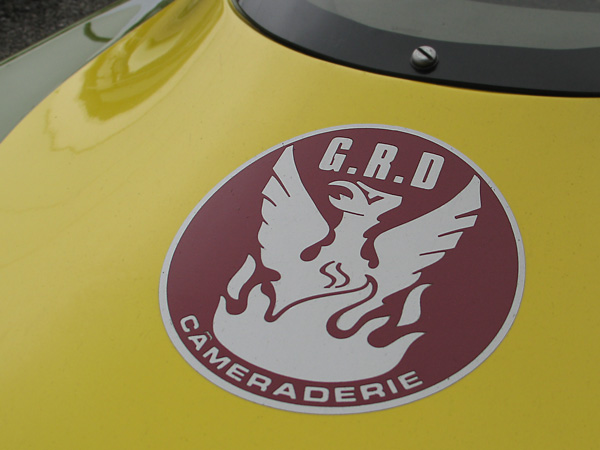
�
Cameraderie
�
"Lotus Components Ltd." reorganized as "Lotus Racing" in 1971, but the company soon failed anyway.
�
Group Racing Developments rose from the ashes of Lotus Racing and took a phoenix as their symbol.
�
�
The business picture looked promising at the start. G.R.D. would continue relationships �
with teams that had previously preferred Lotus cars. Brabham was withdrawing from the �
market, so there seemed to be great potential for increasing market share. But �
racing is a difficult and rapidly changing business. Participation rapidly declined �
after the Arab oil embargo, and the fuel crisis brought racing in England to a near total �
stop for the 1975 season. Despite a very promising beginning, by the end of 1974 �
G.R.D. would cease operations. The scattered remains of G.R.D. would be picked-up �
by the new Van Diemen company, who have subsequently become well known for successive �
successful Formula Ford models. Van Diemen rebadged the G.R.D. chassis and offered it �
for awhile to Formula 3 teams.�
�
�
 �
�
�
�
�
G.R.D. focused their efforts on two similar racing classes: Formula Two and Formula Three. �
Perhaps we should review the key racing classes of the period. Formula One was the top �
class, with engines restricted to 3L capacity (normally aspirated). Formula Two was viewed �
as the last class before drivers graduated to Formula One. Engine capacity was capped at �
1600cc through 1971, rising to 2L from 1972. From 1971, Formula Three engine displacement �
grew (from 1000cc) to 1600cc but the engines had to breath through a 20mm restrictor.�
Generally, it was feasible to convert a car from Formula Two to Formula Three or vice versa.�
�
G.R.D.'s model designations are intuitive. They used three digit numbers, with the first �
digit indicating racing class and the two final digits designating model year. A 272 was �
nominally a Formula Two car built to race in the 1972 season. �
�
All G.R.D. race cars feature aluminum bathtub monocoques with tubular subframes �
front and rear and conventional suspensions. The bodywork had a pronounced wedge shape. �
Side mounted radiators were used on 1972 and 1973 models, but a single front mounted �
radiator was tried in 1974. �
�
How successful were they? G.R.D. cars clearly won their share of races, especially in �
Formula Three. Roger Williamson won the Formula Three "Shell/Motor Sport International" �
Championship in 1972. In the 1973 Formula Three season Alan Jones, Brian Henton and Richard �
Robarts chalked up 9 wins between them. In 1975 Renzo Zorzi won the Formula Three race �
at Monaco. �
�
�
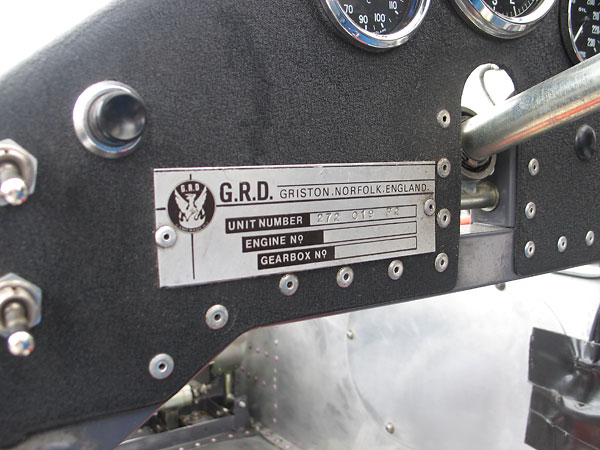
�
G.R.D. Griston. Norfolk. England.
�
Unit No. 272 019 F2 - Engine No. (blank) - Gearbox No. (blank)
�
Michael Snowdon's G.R.D.
��
Michael Snowdon's 272 has a lot of Canadian history. It was owned by Jacques Couture �
(1960's racer and husband of Jim Russell's daughter), and it was also driven by �
Montreal racer Dave McConnell in both the Tasman series and in European events �
after being temporarily reconfigured to Formula Three requirements. �
�
Michael bought the car in 2005 and sent it back to England for restoration. Peter Denty, �
who worked at G.R.D. throughout the company's entire run, restored it over the winter �
and it was ready for North American vintage racing starting in 2006.�
�
Enjoying this article? www.BritishRaceCar.com is partially funded through generous support from readers like you!
�
To contribute to our operating budget, please click here and follow the instructions.
�
(Suggested contribution is twenty bucks per year. Feel free to give more!)�
Features and Specifications
�| Engine: | �Ford BDE (Belt Drive E-Type) 1.8L DOHC 16-valve inline four cylinder engine. �
Lucas ignition system. Dual Weber DCOE carburetors. Dry sump lubrication system. | �
| Cooling: | �dual side-mounted radiators. | �
| Exhaust: | �4-into-1 header. | �
| Transaxle: | �Hewland FG400 5-speed. Dual-plate QuarterMaster clutch. | �
| Front Susp.: | �double wishbone suspension with outboard coilovers and brakes, �
and conventional adjustable antisway bar. G.R.D. proprietary magnesium uprights. | �
| Rear Susp.: | �dual lower links, single top links, and twin adjustable trailing links.�
Outboard coilover shock absorbers and inboard brakes. �
Adjustable antisway bar. G.R.D. proprietary magnesium uprights. | �
| Brakes: | �(master) dual Girling master cylinders with bias bar, � (front) AP Lockheed four piston calipers with vented rotors, � (rear) inboard mounted AP Lockheed calipers with solid rotors. | �
| Wheels/Tires: | �G.R.D. cast magnesium wheels with Avon 13" racing slicks (9x20 front, 13x23 rear). | �
| Electrical: | �Ark Racing starter motor. | �
| Instruments: | �(left to right) Smiths dual oil pressure (0-160psi) and coolant temperature (30-120C) gauge,�
Smiths mechanical tachometer (0-12000rpm), and Smiths oil temperature gauge (90-230F). | �
| Fuel System: | �dual side-mounted fuel cells. | �
| Safety Eqpmt: | �Willans six point cam-lock safety harness. �
S.P.A. Firefighter aqueous film forming foam (AFFF) centralized fire suppression system.�
Quick release steering wheel hub.�
50 LED rain light. | �
| Weight: | �1020lbs | �
| Completion: | �rebuilt 2005-2006 by Peter Denty Racing, near Thetford, Norfolk. | �
| Racing Class: | �Formula 2 / SVRA 9FA | �
Engine Installation
��
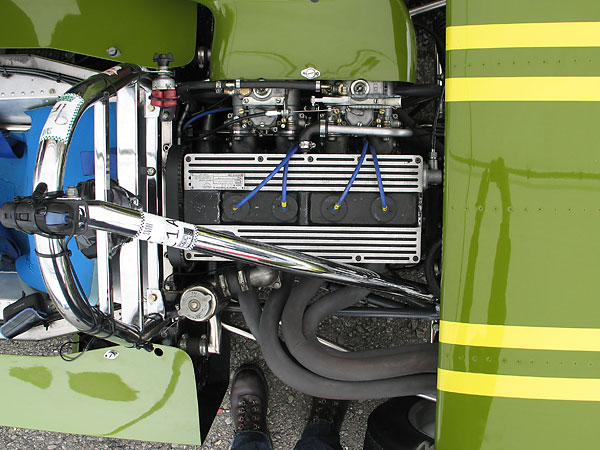
�
The BD series of Cosworth/Ford belt-driven dual overhead cam engines date from 1969.
�
This "BDE" engine is the fifth generation of the design.
�
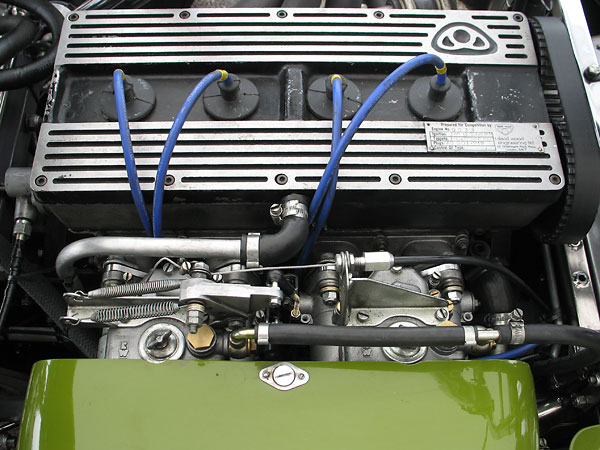
�
Dual Weber DCOE carburetors.
�
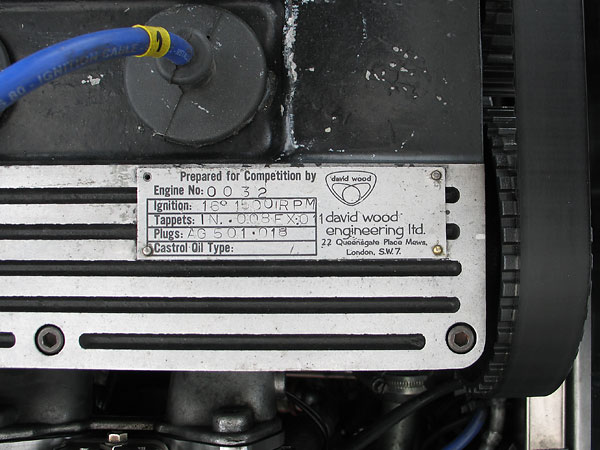
�
Prepared for Competition by David Wood, Engine Number 0032
�
Ignition: 16o 1500rpm - Tappets: inlet .008 exhaust .011 - Plugs: AG 501.018
�
David Wood Engineering Ltd., 22 Queensgate Place Mews, London, S.W.7.
�
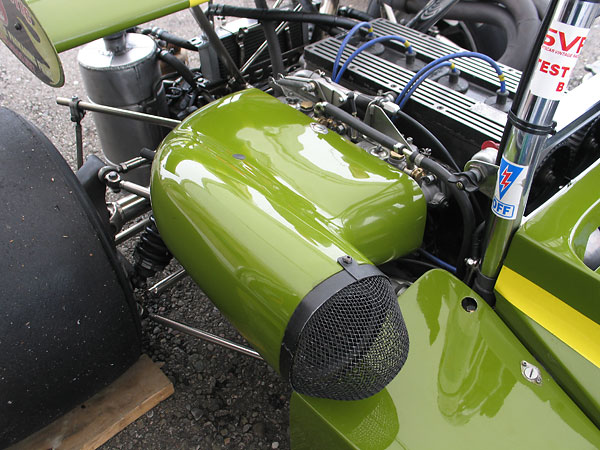
�
Air intake.
�
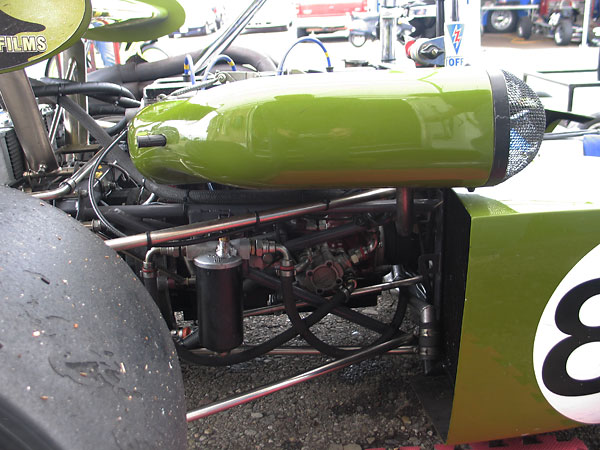
�
The drive gear for the dry sump oil pump and the distributor are on a jackshaft on this side of the engine.
�
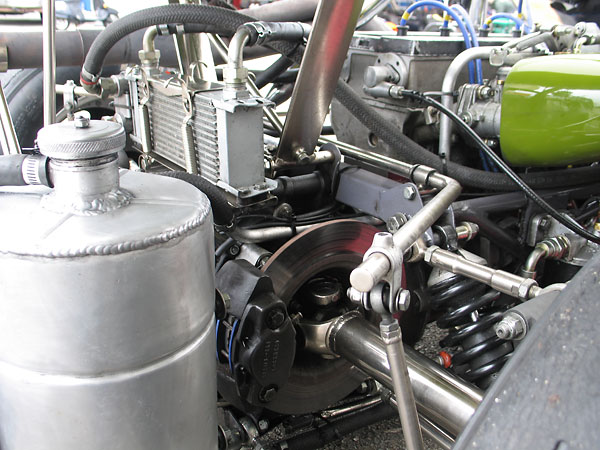
�
The mechanical tachometer is driven from the back end of the righthand camshaft.
�
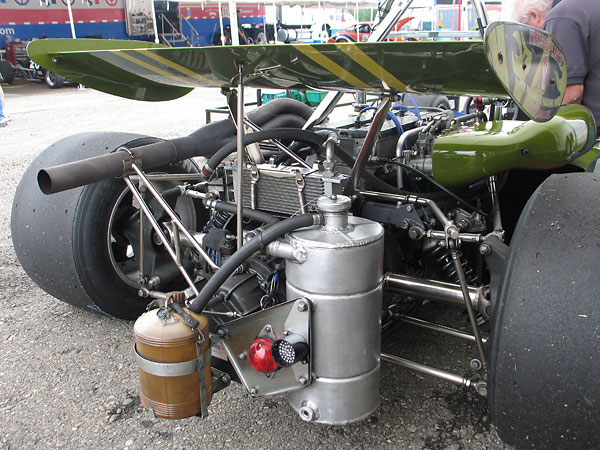
�
Oil cooler, and the reservoir for the dry sump lubrication system.
�
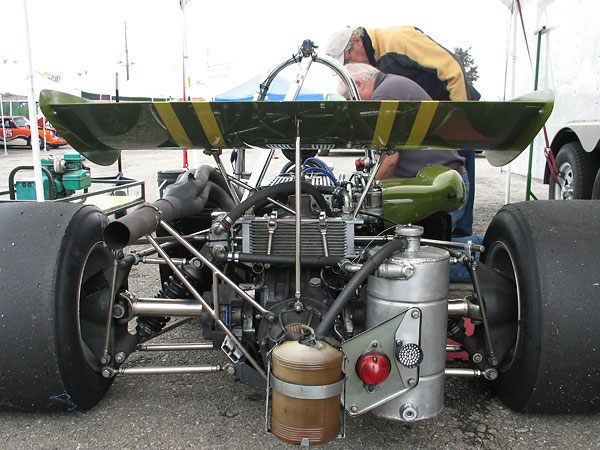
�
50 LED rain light.
�
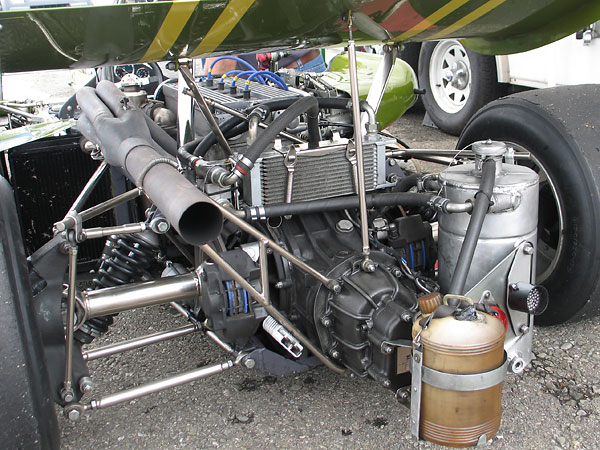
�
AP Lockheed two-piston brake calipers.
�
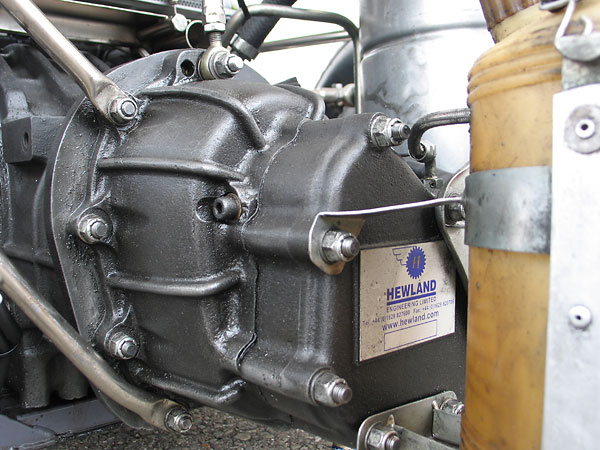
�
Hewland FG400 5-speed.
�
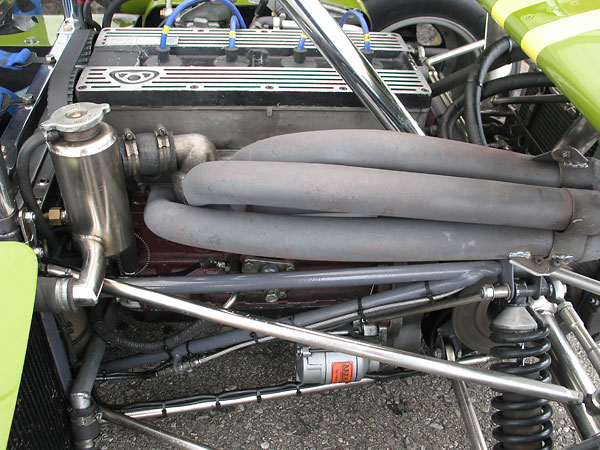
�
Custom four into one exhaust headers.
�
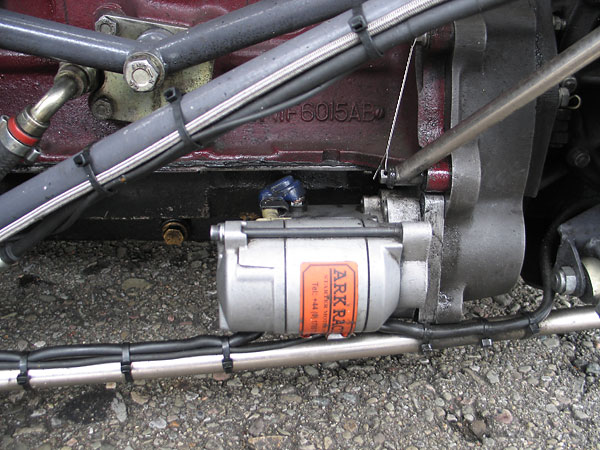
�
Ark Racing starter motor.
�
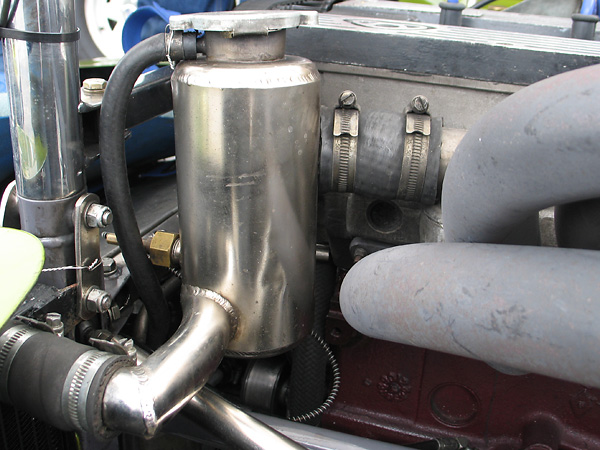
�
Stainless steel swirl pot helps deaerate the coolant.
�
�
Suspension
��
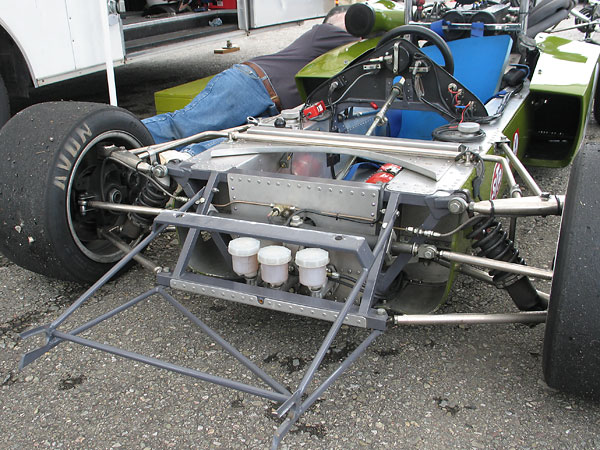
�
A lightweight frame projects forward from the chassis to support the nose cone.
�
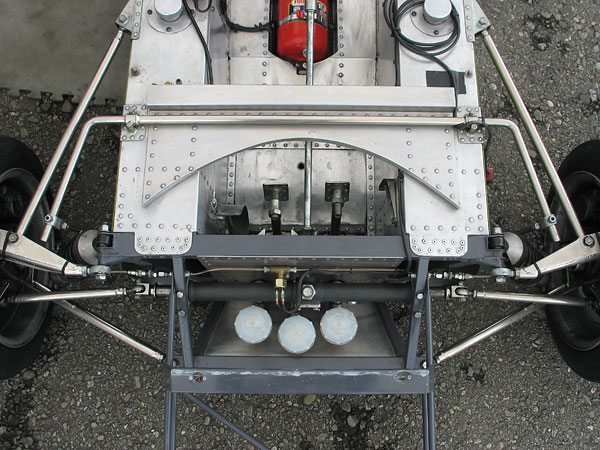
�
At the front of the tub, a steel subframe provides mounting points for the coilover shock absorbers,
�
for the forward arms of the upper and lower wishbones, and for the steering rack.
�
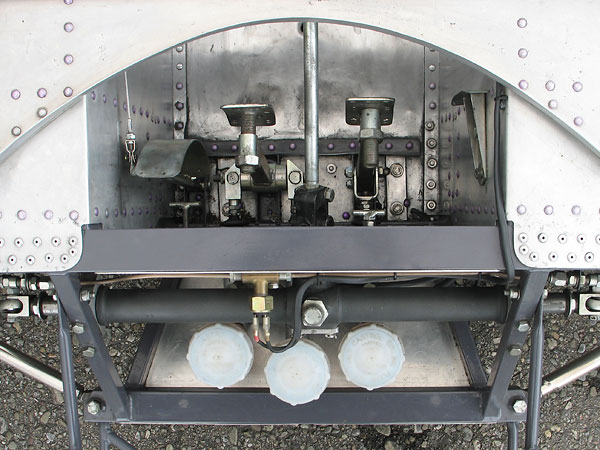
�
Dual Girling master cylinders with adjustable bias bar.
�
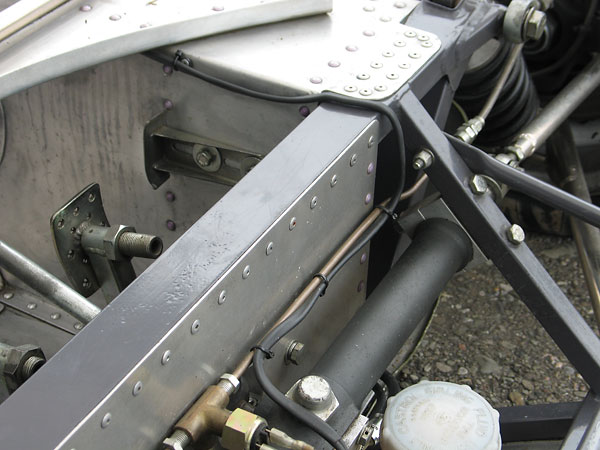
�
Easily adjustable "dead pedal" for the driver's clutch foot.
�
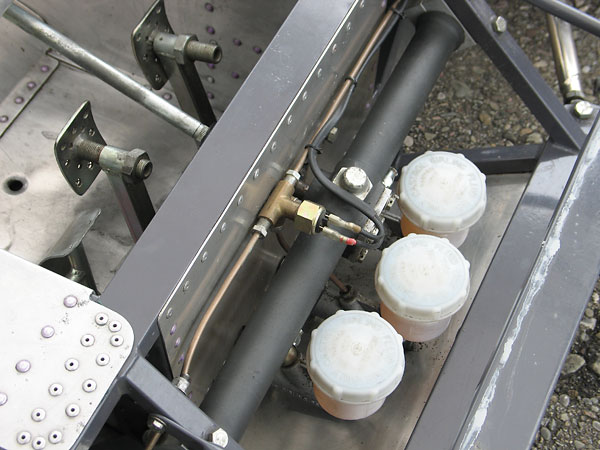
�
Steering rack and brake light switch.
�
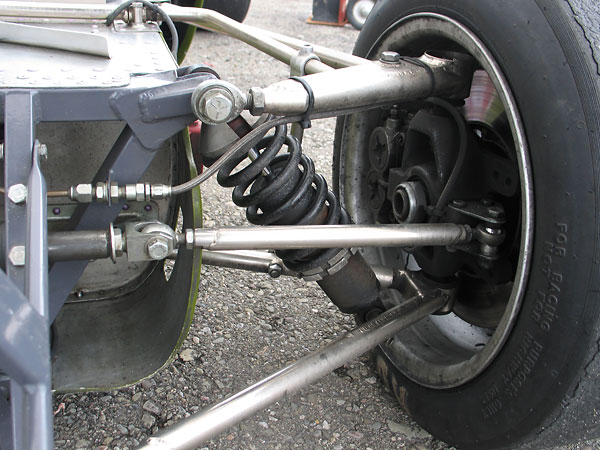
�
�
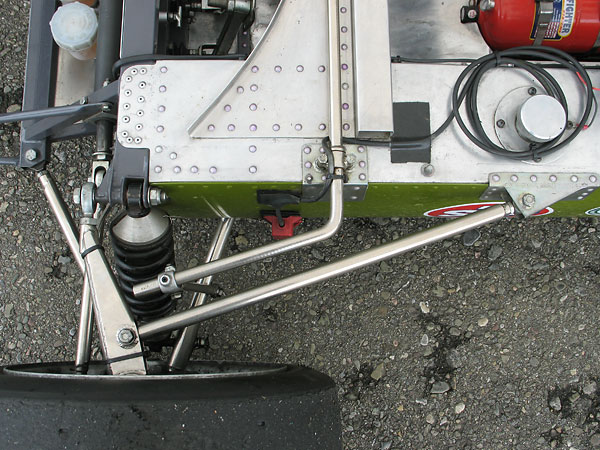
�
AMB TranX260 direct wire transponder.
�
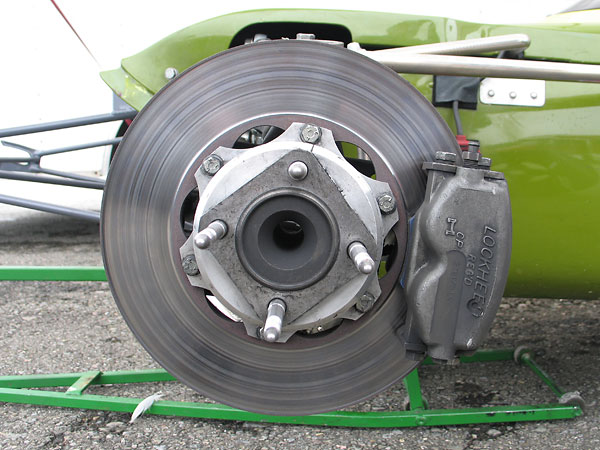
�
�
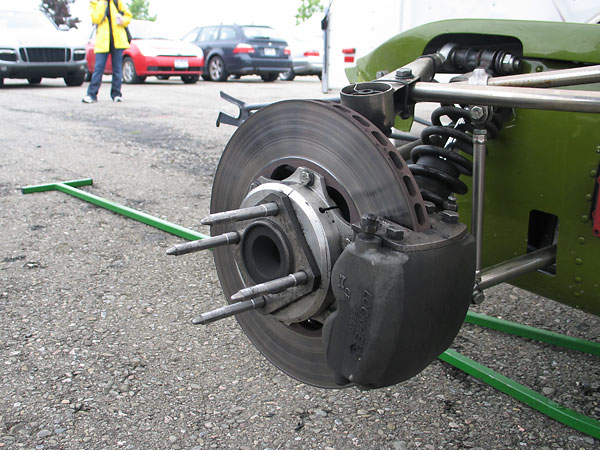
�
�
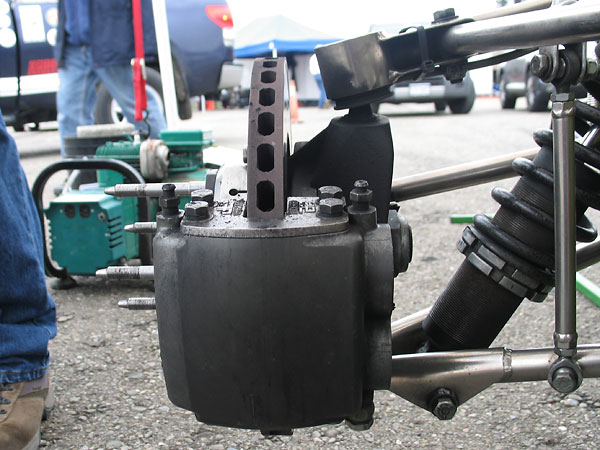
�
AP Lockheed four-piston brake caliper.
�
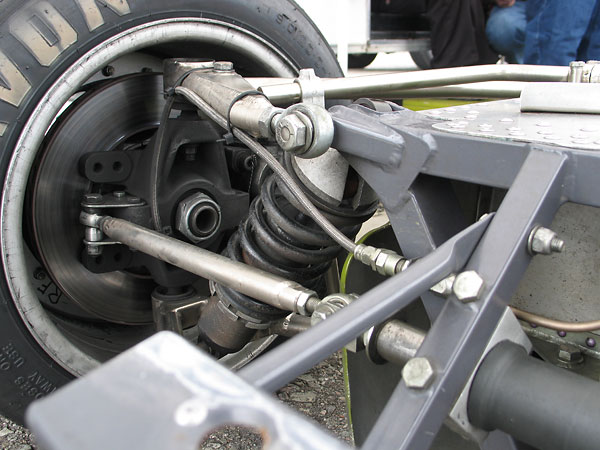
�
G.R.D. proprietary magnesium front upright.
�
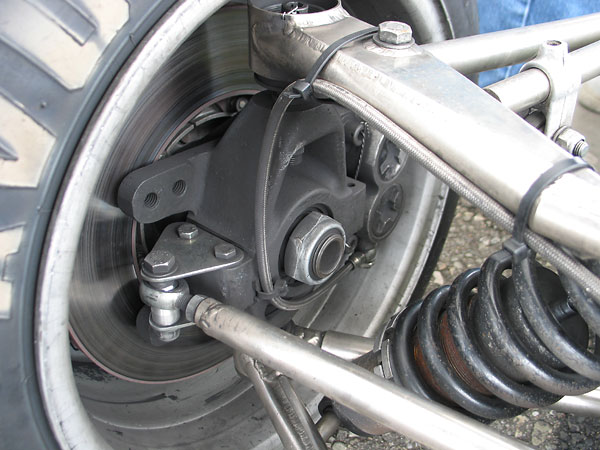
�
Notice that the uprights are interchangeable, left-to-right.
�
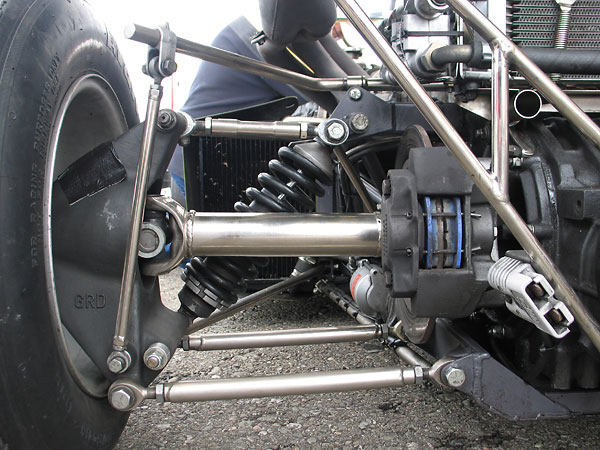
�
G.R.D. proprietary magnesium rear upright.
�
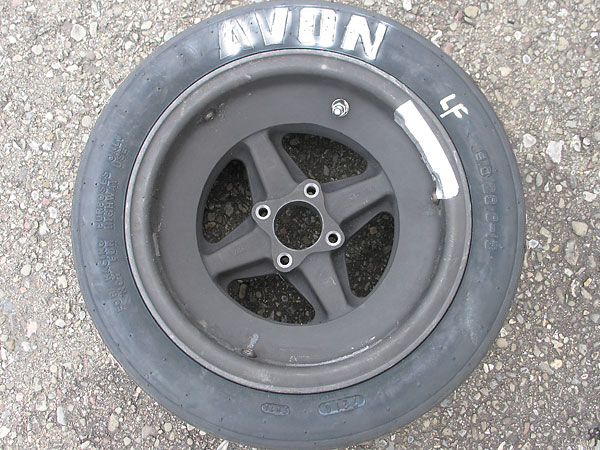
�
G.R.D.'s own distinctive lightweight cast magnesium wheels.
�
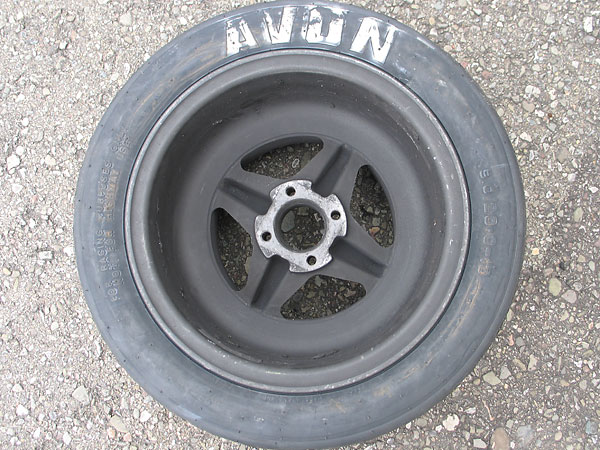
�
Avon 13" racing slicks (9x20 front).
�
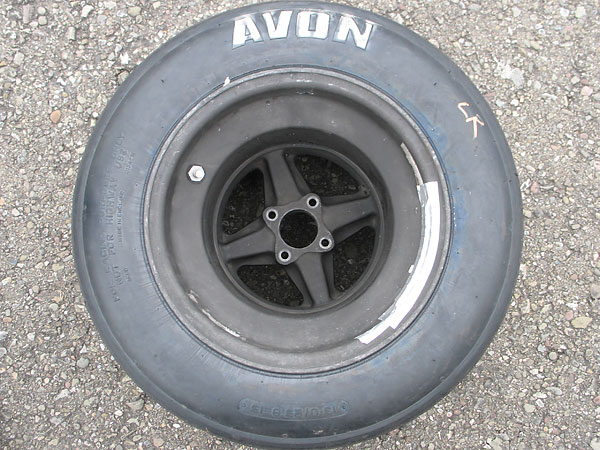
�
Avon 13" racing slicks (13x23 rear).
�
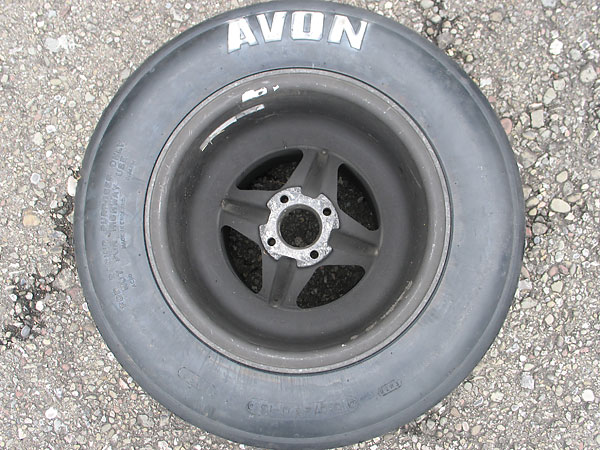
�
�
�
Interior
��
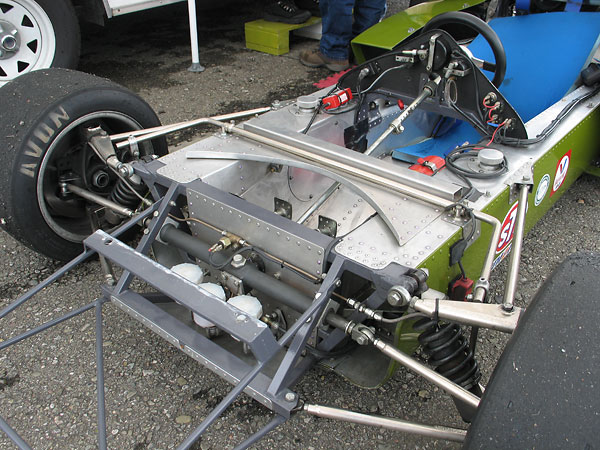
�
�
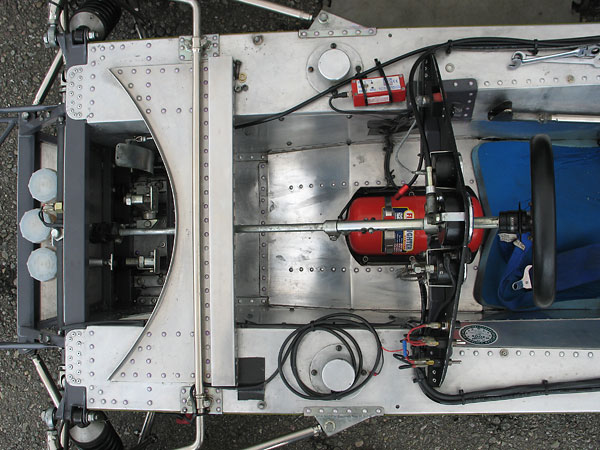
�
�
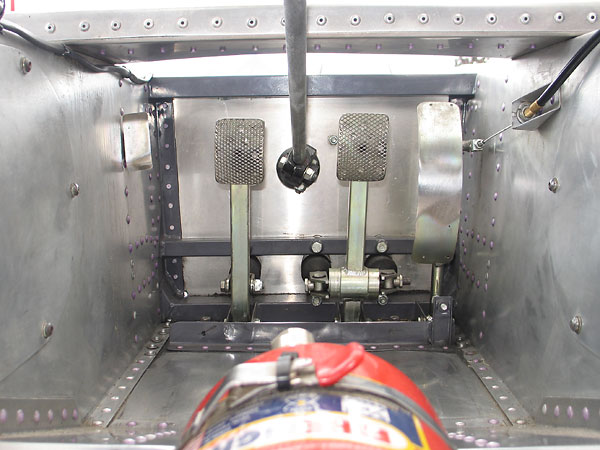
�
�
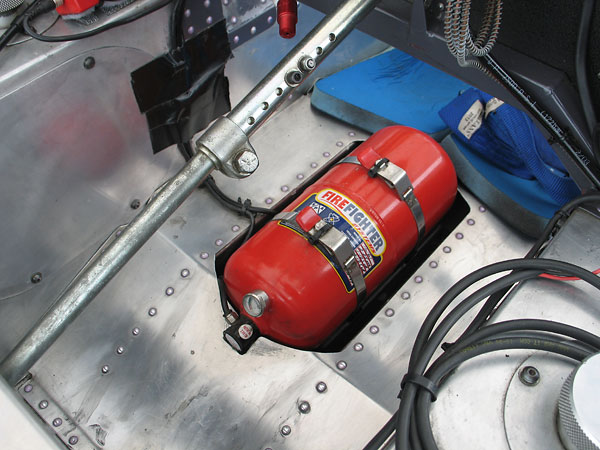
�
S.P.A. "Firefighter" aqueous film forming foam (AFFF) centralized fire suppression system.
�
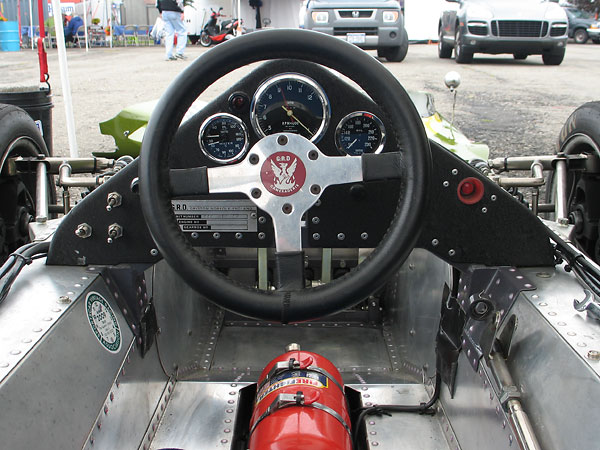
�
(left to right) Smiths dual oil pressure (0-160psi) and coolant temperature (30-120C) gauge,
�
Smiths mechanical tachometer (0-12000rpm), and Smiths oil temperature gauge (90-230F).
�
�
Exterior
��
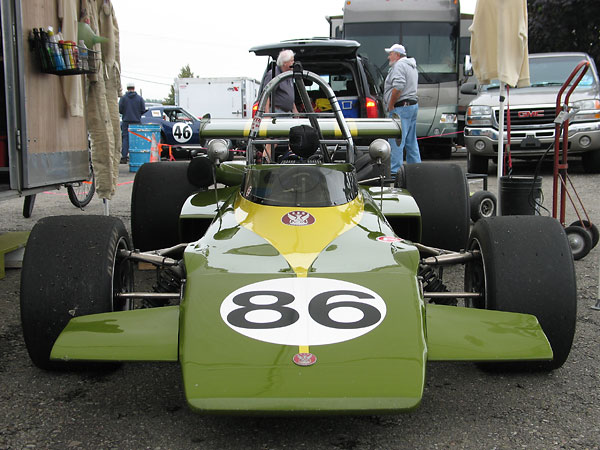
�
What's the story with this color scheme? These colors were chosen by Jim Russell and used
�
both on Jim Russell Racing Drivers School's training cars (from about 1969) and also on
�
racecars they sponsored. Both Jacques Couture and Dave McConnell had JRRDS sponsorship.
�
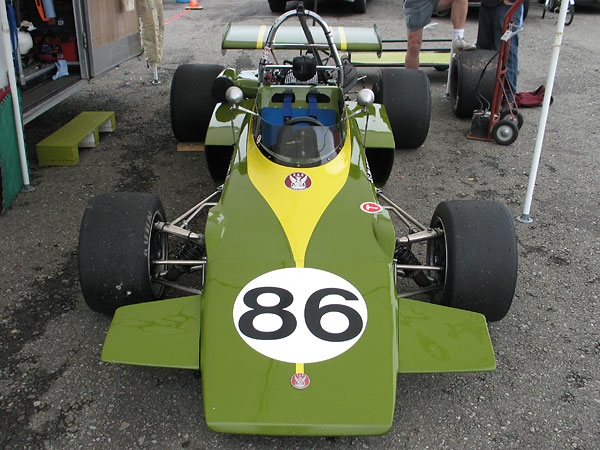
�
Emerson Fittipaldi, Dave Walker, Carlos Pace and Mo Harness all drove Lotus racecars in
�
this color scheme. When G.R.D. rose from Lotus ashes, the color scheme carried over.
�
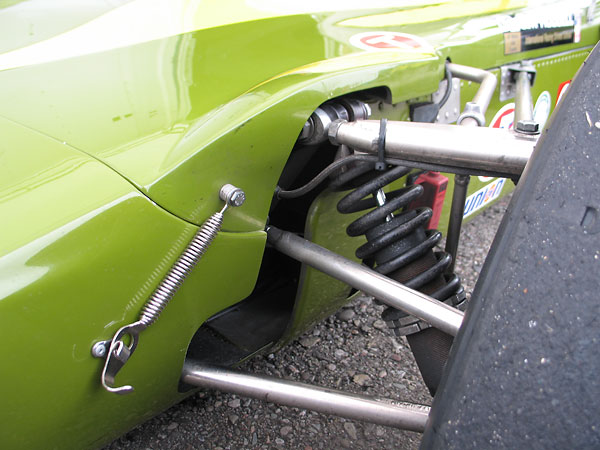
�
Terry body hold down springs.
�
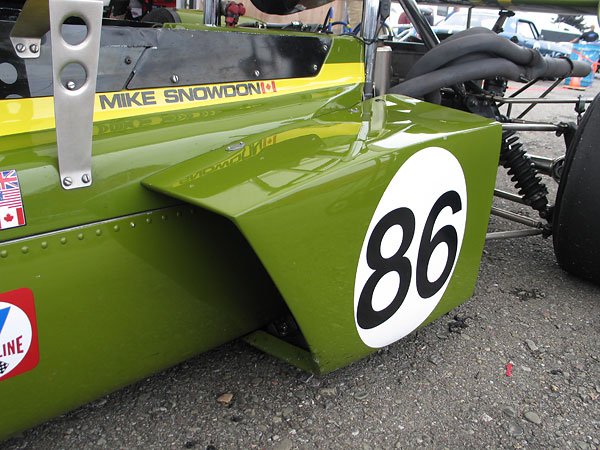
�
One of two side pods for the radiators.
�
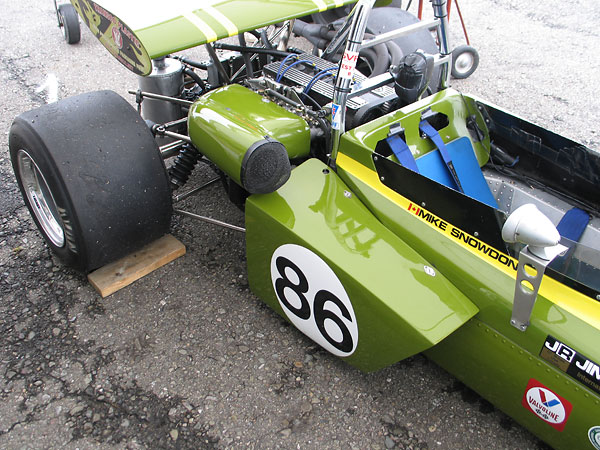
�
�
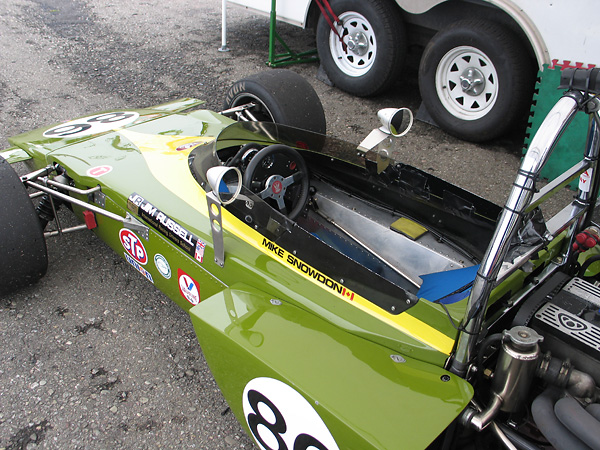
�
�
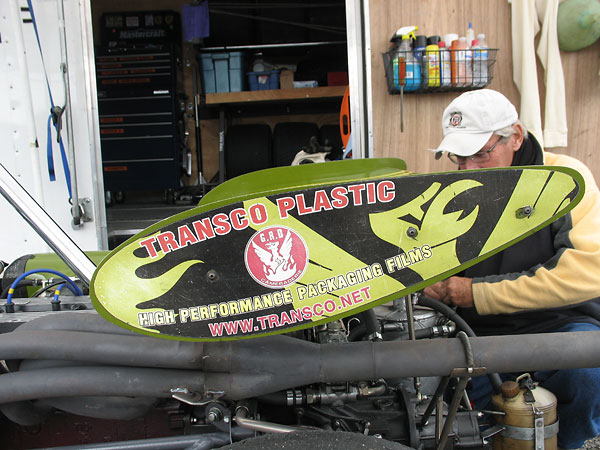
�
Transco Plastic - High Performance Packaging Films - www.transco.net
�
�
All photos shown here are from September 2009 when we viewed the car at The US Vintage Grand �
Prix at Watkins Glen. All photos by Curtis Jacobson and Don Moyer for BritishRaceCar.com, copyright 2009. �
All rights reserved.
�
| If you liked this article, you'll probably also enjoy these: | �|||||
 | �
Mike Knittel '70 Chinook Mk12 | �
 | �
Kyle Kaulback '71 Lotus 69 FB | �
 | �
Jim Stengel '73 McRae GM-1 | �
| You're invited to discuss anything you've seen here on The British Racecar Motorsports Forum! | �|||||
�
Notice: all the articles and almost all the photos on BritishRacecar.com are by Curtis Jacobson.
�
(Photos that aren't by Curtis are explicitly credited.) Reproduction without prior written permission is prohibited.
�
Contact us to purchase images or reproduction permission. Higher resolution images are optionally available.
�

 �
�